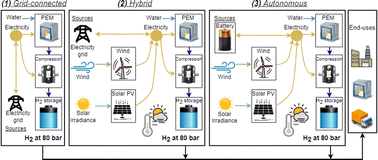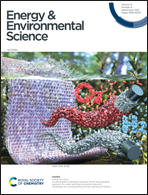Large-scale hydrogen production via water electrolysis: a techno-economic and environmental assessment†
Abstract
Low-carbon (green) hydrogen can be generated via water electrolysis using photovoltaic, wind, hydropower, or decarbonized grid electricity. This work quantifies current and future costs as well as environmental burdens of large-scale hydrogen production systems on geographical islands, which exhibit high renewable energy potentials and could act as hydrogen export hubs. Different hydrogen production configurations are examined, considering a daily hydrogen production rate of 10 tonnes, on hydrogen production costs, life cycle greenhouse gas emissions, material utilization, and land transformation. The results demonstrate that electrolytic hydrogen production costs of 3.7 Euro per kg H2 are within reach today and that a reduction to 2 Euro per kg H2 in year 2040 is likely, hence approaching cost parity with hydrogen from natural gas reforming even when applying “historical” natural gas prices. The recent surge of natural gas prices shows that cost parity between green and grey hydrogen can already be achieved today. Producing hydrogen via water electrolysis with low costs and low GHG emissions is only possible at very specific locations nowadays. Hybrid configurations using different electricity supply options demonstrate the best economic performance in combination with low environmental burdens. Autonomous hydrogen production systems are especially effective to produce low-carbon hydrogen, although the production of larger sized system components can exhibit significant environmental burdens and investments. Some materials (especially iridium) and the availability of land can be limiting factors when scaling up green hydrogen production with polymer electrolyte membrane (PEM) electrolyzers. This implies that decision-makers should consider aspects beyond costs and GHG emissions when designing large-scale hydrogen production systems to avoid risks coming along with the supply of, for example, scarce materials.



 Please wait while we load your content...
Please wait while we load your content...